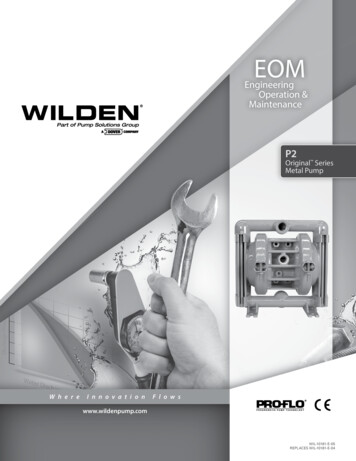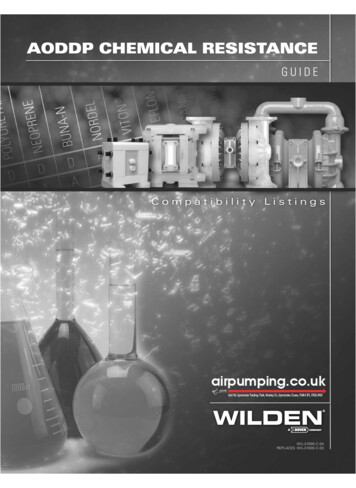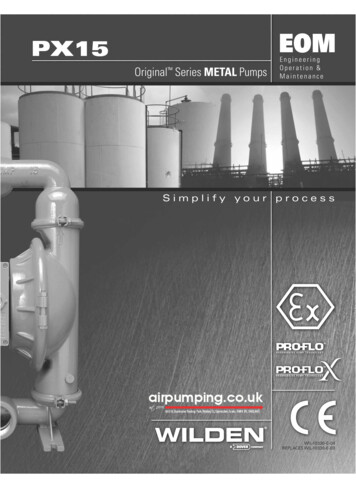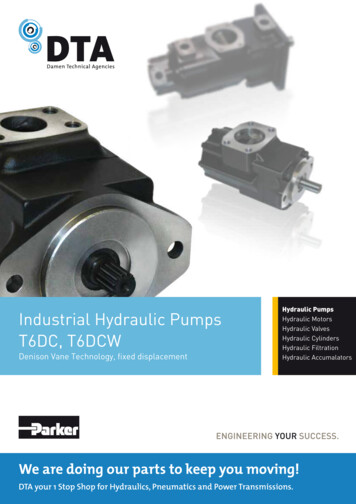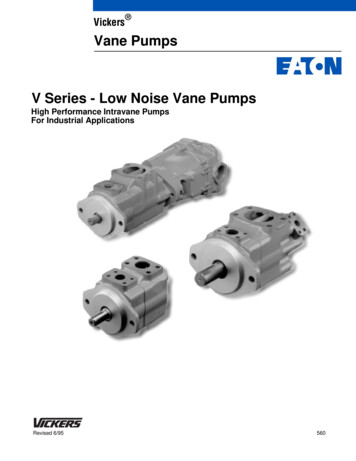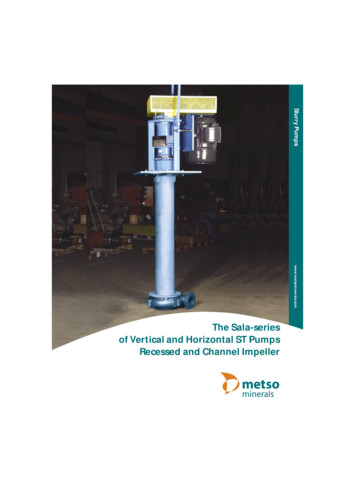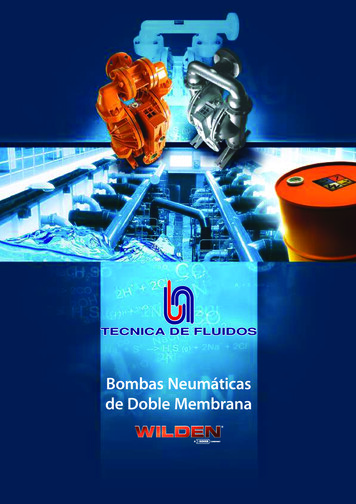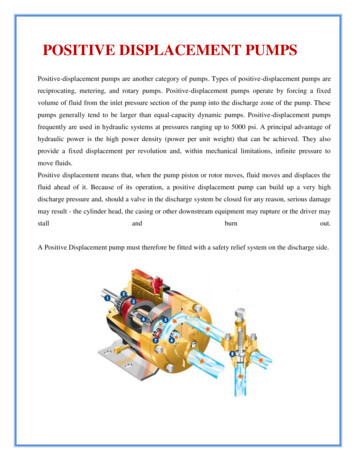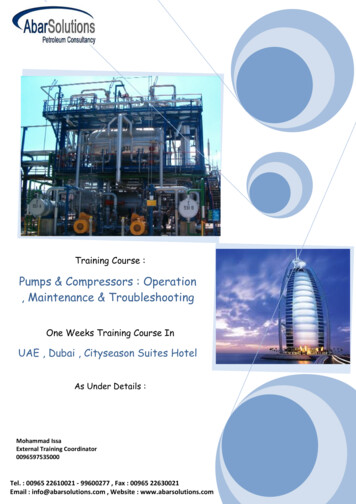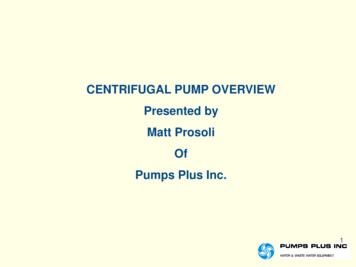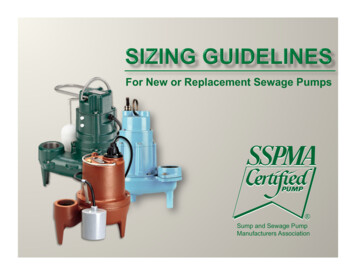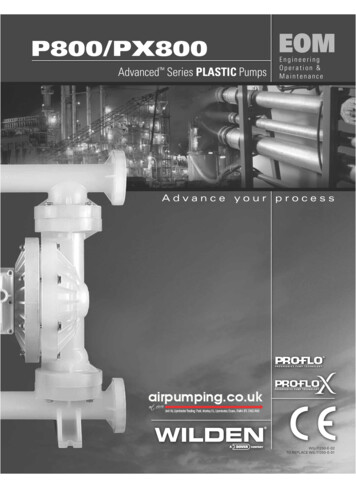
Transcription
P800/PX800Advanced Series PLASTIC PumpsEngineeringOperation &MaintenanceAdvance your processWIL-11250-E-02TO REPLACE WIL-11250-E-01
TA BL E OF CON T EN T SSECTION 1 CAUTIONS—READ FIRST! . . . . . . . . . . . . . . . . . . . . . . . . . . . . . . . . . . . . . . . . . . . . . .1SECTION 2 WILDEN PUMP DESIGNATION SYSTEM . . . . . . . . . . . . . . . . . . . . . . . . . . . . . . . . .2SECTION 3 HOW IT WORKS—PUMP & AIR DISTRIBUTION SYSTEM. . . . . . . . . . . . . . . .3SECTION 4 DIMENSIONAL DRAWINGS . . . . . . . . . . . . . . . . . . . . . . . . . . . . . . . . . . . . . . . . . . . . .4SECTION 5 PERFORMANCEA. P800 Performance CurvesRubber-Fitted . . . . . . . . . . . . . . . . . . . . . . . . . . . . . . . . . . . . . . . . . . . . . . . . . . . . . . . .6TPE-Fitted . . . . . . . . . . . . . . . . . . . . . . . . . . . . . . . . . . . . . . . . . . . . . . . . . . . . . . . . . . .6PTFE-Fitted . . . . . . . . . . . . . . . . . . . . . . . . . . . . . . . . . . . . . . . . . . . . . . . . . . . . . . . . . .7Full Stroke-Fitted . . . . . . . . . . . . . . . . . . . . . . . . . . . . . . . . . . . . . . . . . . . . . . . . . . . . .7Ultra-Flex -Fitted . . . . . . . . . . . . . . . . . . . . . . . . . . . . . . . . . . . . . . . . . . . . . . . . . . . .8Suction Lift Curve . . . . . . . . . . . . . . . . . . . . . . . . . . . . . . . . . . . . . . . . . . . . . . . . . . . .9B. PX800 Performance CurvesOperating Principal . . . . . . . . . . . . . . . . . . . . . . . . . . . . . . . . . . . . . . . . . . . . . . . . . . . .12How to Use this EMS Curve . . . . . . . . . . . . . . . . . . . . . . . . . . . . . . . . . . . . . . . . . . . . .13Performance CurvesRubber-Fitted . . . . . . . . . . . . . . . . . . . . . . . . . . . . . . . . . . . . . . . . . . . . . . . . . . . .16TPE-Fitted . . . . . . . . . . . . . . . . . . . . . . . . . . . . . . . . . . . . . . . . . . . . . . . . . . . . . . .17PTFE-Fitted . . . . . . . . . . . . . . . . . . . . . . . . . . . . . . . . . . . . . . . . . . . . . . . . . . . . . .18Full Stroke-Fitted . . . . . . . . . . . . . . . . . . . . . . . . . . . . . . . . . . . . . . . . . . . . . . . . . .19Ultra-Flex -Fitted . . . . . . . . . . . . . . . . . . . . . . . . . . . . . . . . . . . . . . . . . . . . . . . . 20Suction Lift Curve . . . . . . . . . . . . . . . . . . . . . . . . . . . . . . . . . . . . . . . . . . . . . . . . . . .21SECTION 6 SUGGESTED INSTALLATION, OPERATION & TROUBLESHOOTING . . . . . . .23SECTION 7 DISASSEMBLY/REASSEMBLYPump Disassembly . . . . . . . . . . . . . . . . . . . . . . . . . . . . . . . . . . . . . . . . . . . . . . . . . . . . . . .25Pro-Flo Air Valve / Center Section Disassembly . . . . . . . . . . . . . . . . . . . . . . . . . . . . . . .29Pro-Flo XTM Air Valve / Center Section Disassembly . . . . . . . . . . . . . . . . . . . . . . . . . . . .32Reassembly Hints & Tips . . . . . . . . . . . . . . . . . . . . . . . . . . . . . . . . . . . . . . . . . . . . . . . . . .34SECTION 8 EXPLODED VIEW & PARTS LISTINGP800 PLASTICP800 Full Stroke-Fitted . . . . . . . . . . . . . . . . . . . . . . . . . . . . . . . . . . . . . . . . . . . . . . . . .36P800 Reduced Stroke-Fitted . . . . . . . . . . . . . . . . . . . . . . . . . . . . . . . . . . . . . . . . . . . . .38PX800 PLASTICPX800 Full Stroke-Fitted . . . . . . . . . . . . . . . . . . . . . . . . . . . . . . . . . . . . . . . . . . . . . . . .40PX800 Reduced Stroke-Fitted . . . . . . . . . . . . . . . . . . . . . . . . . . . . . . . . . . . . . . . . . . . .42SECTION 9 ELASTOMER OPTIONS . . . . . . . . . . . . . . . . . . . . . . . . . . . . . . . . . . . . . . . . . . . . . . . . .44
Section 1CAUTIONS—READ FIRST!CAUTION: Do not apply compressed air to theexhaust port — pump will not function.CAUTION: Always wear safety glasses whenoperating pump. If diaphragm rupture occurs,material being pumped may be forced out airexhaust.CAUTION: Do not over-lubricate air supply —excess lubrication will reduce pump performance.Pump is pre-lubed.CAUTION: Before any maintenance or repair isattempted, the compressed air line to the pumpshould be disconnected and all air pressureallowed to bleed from pump. Disconnect allintake, discharge and air lines. Drain the pumpby turning it upside down and allowing any fluidto flow into a suitable container.TEMPERATURE LIMITS:Neoprene–17.7 C to 93.3 C0 F to 200 FBuna-N–12.2 C to 82.2 C10 F to 180 FEPDM–51.1 C to 137.8 C –60 F to 280 F–40 C to 176.7 C –40 F to 350 FViton Saniflex –28.9 C to 104.4 C –20 F to 220 FPolytetrafluoroethylene (PTFE)4.4 C to 104.4 C 40 F to 220 FPolyurethane –12.2 C to 65.6 C10 F to 150 FTetra-Flex PTFE w/Neoprene Backed4.4 C to 107.2 C 40 F to 225 FTetra-Flex PTFE w/EPDM Backed-10 C to 137 C14 F to 280 FCAUTION: Blow out air line for 10 to 20 secondsbefore attaching to pump to make sure all pipelinedebris is clear. Use an in-line air filter. A 5µ (micron)air filter is recommended.CAUTION: If the pipe plug in the inlet or dischargemanifold on the 51 mm (2") Advanced plasticcenter-ported model is removed, a triple density(red) PTFE pipe tape is recommended to ensureadequate sealing.NOTE: Not all materials are available for allmodels. Refer to Section 2 for material optionsfor your pump.NOTE: When installing PTFE diaphragms, it isimportant to tighten outer pistons simultaneously(turning in opposite directions) to ensure tight fit.(See torque specifications in Section 7.)CAUTION: When choosing pump materials, besure to check the temperature limits for all wettedcomponents. Example: Viton has a maximumlimit of 176.7 C (350 F) but polypropylene has amaximum limit of only 79 C (175 F).NOTE: Before starting disassembly, mark a linefrom each liquid chamber to its corresponding airchamber. This line will assist in proper alignmentduring reassembly.CAUTION: Maximum temperature limits arebased upon mechanical stress only. Certainchemicals will significantly reduce maximumsafe operating temperatures. Consult ChemicalResistance Guide (E4) for chemical compatibilityand temperature limits.CAUTION: Pro-Flo pumps cannot be used insubmersible applications. Pro-Flo X is availablein both submersible and non-submersibleoptions. Do not use non-submersible Pro-Flo X models in submersible applications.WARNING: Prevention of static sparking — Ifstatic sparking occurs, fire or explosion couldresult.CAUTION: Tighten all hardware prior to installation.CAUTION: Do not exceed 8.6 bar (125 psig) airsupply pressure.CAUTION: The process fluid and cleaning fluidsmust be chemically compatible with all wettedpump components. Consult Chemical ResistanceGuide (E4).CAUTION: Do not exceed 82 C (180 F) air inlettemperature for Pro-Flo X models.WIL-11250-E-021WILDEN PUMP & ENGINEERING, LLC
Section 2W IL DEN PUMP DESIGN AT ION SYS T EMLEGENDP800/PX800 PLASTICPX800 / XXXXX / XXX / XX / XXX / XXXX51 mm (2") PumpMaximum Flow Rate:693 lpm (183 gpm)MODELO-RINGSVALVE SEATVALVE BALLSDIAPHRAGMSAIR VALVECENTER BLOCKAIR CHAMBERSWETTED PARTS & OUTER PISTONSPECIALTYCODE(if applicable)MATERIAL CODESMODELP800 PRO-FLO PX800 PRO-FLO X DIAPHRAGMSBNS BUNA-N (Red Dot)BNU BUNA-N, ULTRA-FLEX EPS EPDM (Blue Dot)EPU EPDM, ULTRA-FLEX FSS SANIFLEX [Hytrel (Cream)]NES NEOPRENE (Green Dot)NEU NEOPRENE, ULTRA-FLEX PUS POLYURETHANE (Clear)TEU PTFE W/EPDMBACK-UP (White)TNU PTFE W/NEOPRENEBACK-UP (White)TSU PTFE W/SANIFLEX BACK-UP (White)VTS VITON (White Dot)VTU VITON , ULTRA-FLEX WFS WIL-FLEX [Santoprene (Orange Dot)]TSS FULL STROKE PTFEW/SANIFLEX BACK-UPTWS FULL STROKE PTFEW/WIL-FLEX BACK-UPWETTED PARTSKK PVDF / PVDFPK POLYPROPYLENE / PVDFAIR CHAMBERSP POLYPROPYLENECENTER BLOCKP POLYPROPYLENEAIR VALVEP POLYPROPYLENEL ACETAL (P800 only)VALVE BALLBN BUNA-N (Red Dot)EP EPDM (Blue Dot)FS SANIFLEX [Hytrel (Cream)]NE NEOPRENE (Green Dot)PU POLYURETHANE (Clear)TF PTFE (White)VT VITON (White Dot)WF WIL-FLEX [Santoprene (Orange Dot)]VALVE SEATK PVDFP POLYPROPYLENEVALVE SEAT & FLANGE O-RINGBN BUNA-NTV PTFE ENCAP. VITON WF WIL-FLEX (Santoprene)SPECIALTY CODES0100010201030206Wil-Gard 110VWil-Gard sensor wires ONLYWil-Gard 220VPFA coated hardware,Wil-Gard II sensor wires ONLY0480 Pump Cycle Monitor (sensor & wires)0483 Pump Cycle Monitor (module, sensor & wires)0485 Pump Cycle Monitor (module, sensor & wires),DIN flange05020504050605130604060806900691PFA CoatedDIN FlangeDIN Flange, PFA CoatedSS outer pistonsDIN flange Wil-Gard II PFA coated hardware, Wil-Gard II 220VCenter-Ported ANSI/DIN ComboCenter-ported, ANSI/DIN combo flange, PFAcoated fasteners0733 Center-ported, Reversed ANSI/DIN comboflange (inlet facing air inlet/discharge facingexhaust)0734 Center-ported, Reversed ANSI/DIN comboflange (inlet facing air inlet/discharge facingexhaust), PFA coated fastenersNOTE: MOST ELASTOMERIC MATERIALS USE COLORED DOTS FOR IDENTIFICATION.NOTE: Not all models are available with all material options.Viton is a registered trademark of DuPont Dow Elastomers.WILDEN PUMP & ENGINEERING, LLC2WIL-11250-E-02
Section 3HOW IT WORKS—PUMPThe Wilden diaphragm pump is an air-operated, positive displacement, self-priming pump. These drawings show flow patternthrough the pump upon its initial stroke. It is assumed the pump has no fluid in it prior to its initial stroke.FIGURE 1 The air valve directs pressurizedair to the back side of diaphragm A. Thecompressed air is applied directly to theliquid column separated by elastomericdiaphragms. The diaphragm acts asa separation membrane between thecompressed air and liquid, balancing theload and removing mechanical stressfrom the diaphragm. The compressedair moves the diaphragm away fromthe center of the pump. The oppositediaphragm is pulled in by the shaftconnected to the pressurized diaphragm.Diaphragm B is on its suction stroke; airbehind the diaphragm has been forcedout to atmosphere through the exhaustport of the pump. The movement ofdiaphragm B toward the center of thepump creates a vacuum within chamber B.Atmospheric pressure forces fluid intothe inlet manifold forcing the inlet valveball off its seat. Liquid is free to movepast the inlet valve ball and fill the liquidchamber (see shaded area).FIGURE 2 When the pressurized diaphragm,diaphragm A, reaches the limit of its dischargestroke, the air valve redirects pressurizedair to the back side of diaphragm B. Thepressurized air forces diaphragm B awayfrom the center while pulling diaphragm Ato the center. Diaphragm B is now on itsdischarge stroke. Diaphragm B forces theinlet valve ball onto its seat due to thehydraulic forces developed in the liquidchamber and manifold of the pump. Thesesame hydraulic forces lift the dischargevalve ball off its seat, while the oppositedischarge valve ball is forced onto its seat,forcing fluid to flow through the pumpdischarge. The movement of diaphragm Atoward the center of the pump creates avacuum within liquid chamber A. Atmospheric pressure forces fluid into the inletmanifold of the pump. The inlet valve ballis forced off its seat allowing the fluid beingpumped to fill the liquid chamber.FIGURE 3 At completion of the stroke,the air valve again redirects air to theback side of diaphragm A, which startsdiaphragm B on its exhaust stroke. Asthe pump reaches its original startingpoint, each diaphragm has gone throughone exhaust and one discharge stroke.This constitutes one complete pumpingcycle. The pump may take several cyclesto completely prime depending on theconditions of the application.HOW IT WORKS—AIR DISTRIBUTION SYSTEMThe Pro-Flo patented air distribution system incorporates twomoving parts: the air valve spool and the pilot spool. The heart ofthe system is the air valve spool and air valve. This valve designincorporates an unbalanced spool. The smaller end of the spoolis pressurized continuously, while the large end is alternatelypressurized then exhausted to move the spool. The spool directspressurized air to one air chamber while exhausting the other.The air causes the main shaft/diaphragm assembly to shift toone side — discharging liquid on that side and pulling liquid inon the other side. When the shaft reaches the end of its stroke,the inner piston actuates the pilot spool, which pressurizes andexhausts the large end of the air valve spool. The repositioningof the air valve spool routes the air to the other air chamber.WIL-11250-E-023WILDEN PUMP & ENGINEERING, LLC
Section 4DIMENSIONAL DR AWINGSP80 0 P l as t i c S i d e - Po rte dDIMENSIONSITEMMETRIC (mm)STANDARD 03.34.816.714.28.29.20.6TUVTUVDIN FLANGE4.9 DIA.6.5 DIA.0.7 DIA.ANSI FLANGE122 DIA.4.8 DIA.152 DIA.6.0 DIA.20 DIA.0.8 DIA.125 DIA.165 DIA.18 DIA.P80 0 P l as t i c C e n te r- Po rte dDIMENSIONSITEMABCDEFGHJKLMNPRSTUVWXWILDEN PUMP & ENGINEERING, LLC4METRIC (mm)STANDARD 8.22299.025410.0150.6DIN / ANSI COMBO152 DIA.6.0 DIA.122 DIA.4.8 DIA.20 DIA.0.8 DIA.WIL-11250-E-02
DIMENSIONAL DR AWINGPX80 0 P l a s t i c S i d e - Po rte dDIMENSIONSITEMMETRIC (mm)STANDARD 7.816.316.714.28.29.20.6TUVTUVPX80 0 P l a s t i c C e n te r- Porte dDIMENSIONSITEMMETRIC 0442436130720822925415VWXWIL-11250-E-02DIN FLANGE4.9 DIA.6.5 DIA.7 DIA.ANSI FLANGE122 DIA.4.8 DIA.154 DIA.6.0 DIA.20 DIA.8 DIA.125 DIA.165 DIA.18 DIA.5STANDARD 14.212.18.29.010.00.6DIN / ANSI COMBO152 DIA.6.0 DIA.122 DIA.4.8 DIA.20 DIA.8 DIA.WILDEN PUMP & ENGINEERING, LLC
Section 5APERFORMANCEP800 PLASTICRUBBER-FITTEDHeight .805 mm (31.7")Width . 605 mm (23.8")Depth . 353 mm (13.9")Est. Ship WeightPolypropylene 32 kg (70
WIL-11250-E-02 3 WILDEN PUMP & ENGINEERING, LLC Section 3 HOW IT WORKS—PUMP The Wilden diaphragm pump is an air-operated, positive displacement, self-priming pump. These drawings show fl ow pattern through the pump upon its initial stroke. It is assumed the pump has no fl uid in it prior to its initial stroke. FIGURE 1 The air valve directs pressurized air to the back side of diaphragm

